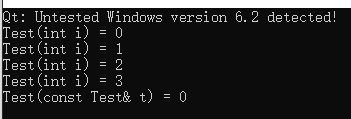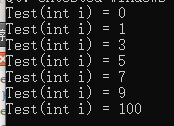实际开发中,因为对象的构造顺序的问题导致bug很多。
那么C++中的类可以定义多个对象,那对象构造的顺序是怎样的?
局部对象
程序执行流到达对象的定义语句时进行构造。
class Test
{
int i;
public:
Test(int i)
{
this->i = i;
cout << "Test(int i) = " << i << endl;
}
Test(const Test& t)
{
this->i = t.i;
cout << "Test(const Test& t) = " << this->i << endl;
}
int value()
{
return i;
}
};
int main()
{
int i = 0;
Test a1 = i;
while( i < 3)
{
Test a2 = ++ i;
}
if( i < 4)
{
Test a3 = a1;
}
else
{
Test a3(100);
}
return 0;
}
输入结果:

构造的过程中不要使用 goto 语句,会带来灾难性的问题
int main()
{
int i = 0;
Test a1 = i;
while( i < 3)
{
Test a2 = ++ i;
}
goto End;
Test a3(100);
End:
a3.value();
return 0;
}不同编译器执行的结果不一样,一般的会提示如下错误

堆对象
当程序执行流到达new语句时创建对象,使用new创建对象将自动触发构造函数的调用。
int main()
{
int i = 0;
Test* a1 = new Test(i); // Test(int i): 0
while( ++i < 10 )
if( i % 2 )
new Test(i); // Test(int i): 1, 3, 5, 7, 9
if( i < 4 )
new Test(*a1);
else
new Test(100); // Test(int i): 100
return 0;
}
全局对象
对象的构造顺序是不确定的,不同的编译器使用不同的规则确定构造顺序。
工程上:
如果对象的构造顺序不定,带来的问题是如果全局对象中里面含有其它类,初始化顺序不定会出错。所以应该避免全局对象。
// test.h
#ifndef _TEST_H_
#define _TEST_H_
#include <stdio.h>
class Test
{
public:
Test(const char* s)
{
printf("%s\n", s);
}
};
#endif
// t1.cpp
#include "test.h"
Test t1("t1");
// t2.cpp
#include "test.h"
Test t2("t2");
// t3.cpp
#include "test.h"
Test t3("t3");
// test.cpp
#include "test.h"
Test t4("t4");
int main()
{
Test t5("t5");
}Linux 下 g++ 编译的结果

小结

